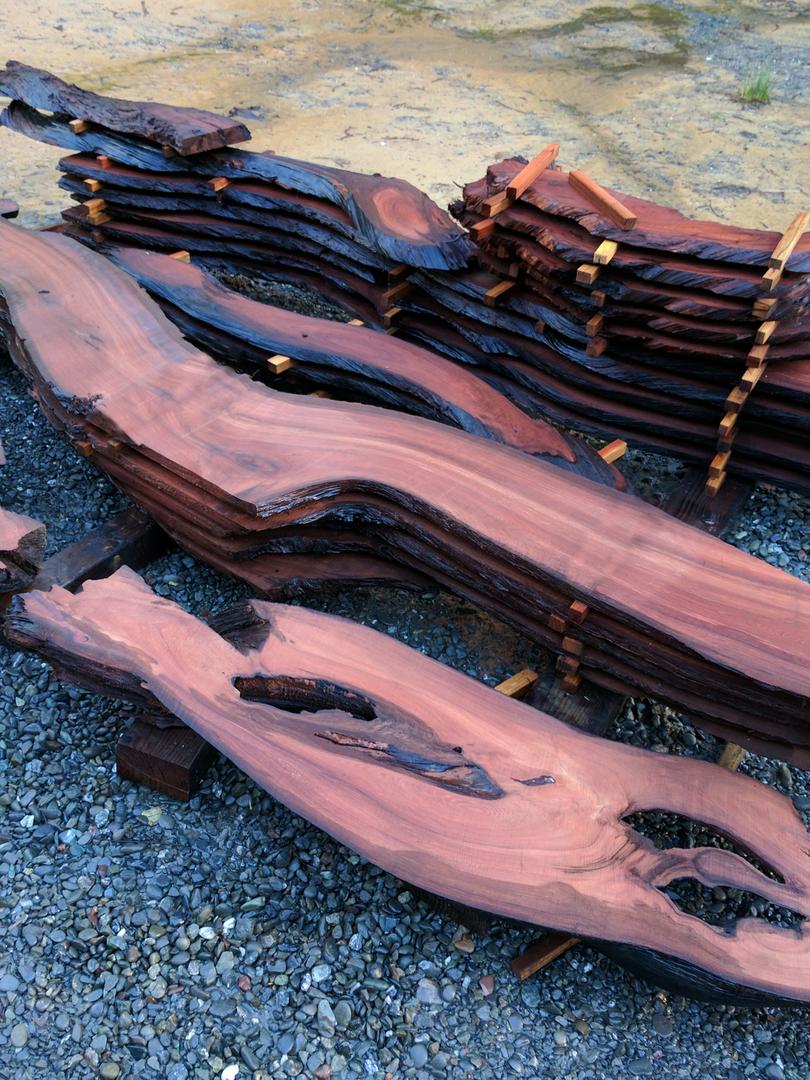A California company is offering redwood lumber from trees that were originally harvested in the 1800s.
Sharp Acres Redwood Milling offers old growth redwood in the traditional tight, straight-grained deep red clear material for architectural applications and furniture. They are also providing dense and heavy root material with a color range from deep reds to bright yellows with curly and other appearances.
The company also offers custom milling of old growth and second growth solid redwood lumber, redwood furniture from raw slabs to completed live edge pieces, and hand-carved slabs and figures by local artists.
No living old growth trees are taken. All wood comes from remnant materials taken from original harvesting in the late 1800s.
Jeff Sharp is the owner of Edgebanding Services Inc. also known as ESI, the largest distributor of edgebanding products in North America.

Sharp was born and raised in Southern California but fell in love with the redwood forest when he attended Humboldt State University in the city of Arcata during the late 1970s. After graduating from HSU, he wanted to stay in Humboldt County but with few job prospects, moved back to Southern California to pursue a career in business.
After working for Woodtape (now Doellken), Sharp started ESI in 1989. After the successes of ESI, he was able to move back to the redwood forest and in 2005 he and his wife purchased a 42-acre parcel of raw timber-producing land in the city of Bayside, California, that they called Sharp Acres.
Sharp said they were surprised by the amount of old growth redwood logs left lying there by the original settlers back in the late 1800s. Those logs are being reclaimed now.
“These very old (some of them as old as 2,000 years) logs can be difficult to find unless you know what to look for,” he said. “Once we figured out how to spot them, we started finding this rare and highly valuable material everywhere. We have already harvested about 5,000 board feet and we have barely scratched the surface.
“We milled some (two 6-foot diameter logs) of what we found into 6-inch to 12-inch x ¾-inch (tongue and groove) panels and completely lined the inside of a recently constructed pool house and found we had twice as much as we needed.”

Old growth logs left from original 1800s harvest.
Besides the old growth lumber, Sharp said they are milling redwood slabs for furniture and display purposes with the live edge look that is currently in demand. And there are many potential slab pieces available lying on or just beneath the ground.
“With all this valuable material just waiting to be found, I decided to buy a sawmill and start a division of ESI called Sharp Acres Redwood Milling (SARM for short),” Sharp said.
Sharp Acres has hundreds of old growth redwood stumps from trees that were harvested years ago, and “snags” (remnants of trees that died) including a 100-foot tall 32-foot diameter snag they named Ancient Wonder. Its age has been estimated to be 5,000 years old and is said to be one of the biggest redwood snags ever found.
Also, Sharp said that for second-growth redwood trees that have to be removed to put in roads and structures, they harvest the trunk of the tree and transplant the root ball to other locations.
“No one thought this could be done successfully and (it) speaks to the resilience of the species,” he said. “You cannot do that with other evergreens.”
“Old growth redwood was used to build everything in the late 1800s and early 1900s, and now whenever an old structure is demolished, like a building, a pier, a bridge, people who are aware of the value of this ancient, beautiful and rare wood are on the lookout for it.”
“A friend of mine owns a construction company and was recently hired to replace a very old wooden water tank with a new larger one. They tore down the old one and were loading it up in a truck to haul it all to the local dump when my friend realized that the old water tank was built with old growth redwood.
“He ended up placing four pallets of 4 inch thick x 8 inch wide x 8 foot long old growth redwood pieces on my property to sell to the highest bidder. We sold three pallets of this completely clear (not one knot) material for more than he made on the job and I got to keep the fourth pallet as payment for our stacking, storing and selling the wood for him. I intend to make something really nice out of the wood I have. See http://www.sharpacres.com.







Have something to say? Share your thoughts with us in the comments below.